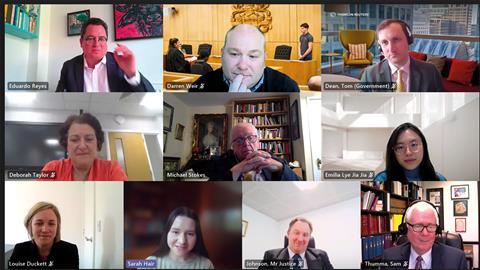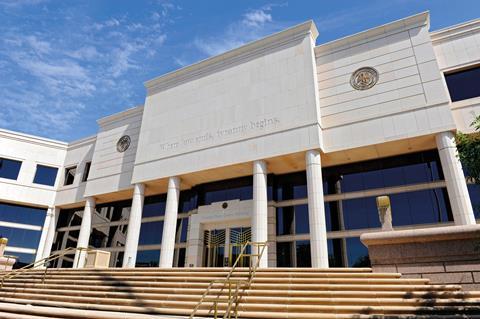While the pandemic heralded a transformation in digitised legal services, a Gazette webinar hears that some processes still rely on physical resources. Joanna Goodman reports

In his introduction to the Gazette webinar on the digital transformation of the courts, organised in partnership with Thomson Reuters, features editor Eduardo Reyes referred to the pandemic driving 10 years of digital adoption almost overnight – and the questions this raised about a digitalised legal sector. What will digitalised court services mean for the justice system, legal services delivery and non-lawyer litigants? New automated online resources raise questions around oversight, accountability and regulation, and the need to ensure fairness and access to justice. What new skills will the next generation of digital lawyers need and how will they be trained now that technology is poised to take over lower-value, routine legal work? These questions and more were explored in a series of presentations and a short panel discussion involving judges, academics, tech experts and law students.
Educating the next generation
Darren Weir, senior lecturer in law at Kent Law School, recently introduced a new four-year masters programme, the MLaw in Advanced Legal Practice. Five key themes run through all modules. Top of the list is technology which is now affecting every area of law. Weir wanted his criminal law students to gain experience using a digital case building tool. He uses Thomson Reuters’ Case Center, which is deployed in multiple courts in England and Wales, as well as internationally, to support his law of evidence module.
In 2022, Kent Law School and Thomson Reuters’ Case Center launched the first (digital) National Law Student Triathlon where teams of students competed in negotiation, advocacy and mooting exercises. At the end of the triathlon, students were asked whether the legal system should be completely paperless – and, surprisingly, about 25% disagreed. However, 91% found the platform easy to use, and 96% would recommend it.
Courts digitisation
High Court judge Jeremy Johnson, who leads for the judiciary on IT live services, explained that courts digitisation involves creating a digital platform for litigation, which allows fundamental change to court procedures, without undertaking decision-making functions.
Even this limited functionality provides opportunities to improve how justice is delivered. ‘It can remove much of the procedural and administrative work which can sometimes befuddle litigants and lawyers, slow down litigation and increase cost,’ he said.
A practical example is the early stages of a civil case, where drafting a claim form and the particulars of the claim in a way that complies with the Civil Procedure Rules often requires a specialist litigator. It will soon be possible for people to use their smartphone to access a digitised service that asks simple questions on screen and uses the answers to generate the required documents. But while this is not yet available, claims can now be brought online, the correct court fees automatically collected, and the claim issued immediately. This takes 11 seconds whereas a paper claim typically takes 11 days.
Another benefit of digitisation is that the rules are shorter and simpler and can be made accessible with online guides and links. The online Civil Money Claims Service for litigants in person who wish to bring debt claims for up to £10,000 has a 95% satisfaction rate among claimants and defendants.
When cases are completed online, decisions are instantly available. Online court orders appear immediately on the portal instead of taking weeks to be published. Digitalised records capture metadata about each case – for example, when a deadline is due to expire – which supports notifications and reminders. Digitisation makes it easier to search court files, and court dockets and listings are publicly available online.
However, there are caveats, Johnson warned. Court digitisation is an iterative process. The technology is released early and improved in the light of user experience, which means users may experience teething difficulties. There is a need for vigilance around fairness and equality, to ensure that digitisation does not aggravate existing inequalities or create new ones. And you need to get the basics right: reliable wifi in courts and sufficient IT support to ensure the system is resilient. Finally, not all cases (especially complex, multi-party cases) can be managed online, and not everyone can access technology, so for now at least there has to be a hybrid system.
Online mental health tribunals
Michael Stokes KC, deputy judge of the Upper Tribunal (Health Education and Social Care Chamber), spoke about virtual mental health tribunals, which make decisions authorising the confinement of individuals under the Mental Health Act. When remote tribunal hearings were introduced during the pandemic, the backlog was reduced significantly. Most mental health tribunals are still held remotely.
While only one in eight hearings are now conducted in person, some hearings are not suitable for digital technology. Patients ‘sectioned’ under Section 2 of the Mental Health Act have to be released after 28 days, unless a decision has been made that they have to stay in hospital, and an application has to be made within 14 days of the sectioning order. Stokes believes that Section 2 hearings are better conducted in hospital, so that relevant information can be collected and passed to the tribunal right up until the hearing. However, digital working has brought considerable improvements. For example, it is possible to conduct more hearings when they are held remotely, and it is a safer way to deal with dangerous patients.
Drawbacks of remote technology include system failure. Stokes related that he declined hearing a case when the video connection failed because he considered it important that the patient should be seen by those who are making decisions affecting their future. Another issue is when out-of-date information is copied and pasted into reports. Digitising documents and processes makes record-keeping and communication easier and more efficient. For example, decisions can be agreed by all tribunal members and immediately emailed to the hospital and anyone else entitled to see them. ‘Digital working in the tribunals has a future,’ said Stokes. ‘It was demonstrated during the Covid pandemic that it can work effectively and fairly, but it must always be the interest of the patient that determines which form of hearing should occur.’
Modernising family law
Louise Duckett, a solicitor at Davis Simmonds & Donaghey and president of Kent Law Society, spoke about the digitisation of family law, covering the move from physical documents, paper bundles and in-person hearings to online and digital processes. All legal aid applications now go through CCMS, the online system for civil and family legal aid providers. This centralised service saves practitioners time, effort and paper, because all the administration is handled in one place.
The downside is that the system has frequent outages.

Software providers help firms produce e-bundles, which are increasingly replacing paper. Duckett used Thomson Reuters’ Case Center during a 45-day child protection case and found that the system ‘completely transformed’ the proceedings. ‘It allowed every party in an online hearing to see the same evidence at the same time,’ she said, adding that as well as being more efficient, e-bundles save paper, and can include videos and links.
However, the software represents an additional cost for small firms and legal aid firms. It is reliant on email and internet access, so litigants in person may not be able to provide e-bundles. Duckett also touched on judicial preference – some judges prefer paper, while others prefer to work online.
Family lawyers can now use the HMCTS portal to issue divorce proceedings and manage child protection cases and other cases involving children. The ability to file documents in one place for easy access by the judge and parties is a clear benefit. However, counsel do not always have access to the portal.
'Case Center completely transformed the proceedings. It allowed every party in an online hearing to see the same evidence at the same time'
Louise Duckett, Davis Simmonds & Donaghey
Virtual hearings using the Cloud Video Platform (CVP) were introduced during the pandemic, and were particularly useful for emergency hearings. CVP hearings allowed judges to work from any location, and deal with emergency injunctions, particularly in domestic abuse cases. They are still used for urgent hearings; yet the family court system has a massive backlog.
The main challenge is that all parties need reliable internet access. Judges can fit in more hearings, but they risk burnout. Pre-hearing discussions and cross-examination techniques do not work as well online, and managing bundles and documents requires a robust IT system. Other difficulties include the availability of support, particularly in child protection cases. Accessibility is another issue, for example parents struggling to join hearings via a mobile phone with no way of communicating with their lawyer, or accessing documents on another device. Duckett highlighted studies which raised concerns about the fairness of remote hearings in cases involving children or domestic abuse, and issues with intermediaries and interpreters.
Other difficulties included the lack of guidance on CVP protocols – that is, which hearings should be held via CVP and which should not, resourcing challenges, and listing and administrative issues.
While online and digital resources have made family law more efficient, Duckett believes there is still a long way to go, in terms of investing in a fair and accessible infrastructure for family cases.
Technology – the us experience

The presentation was followed by a panel introduced by Samuel Thumma (pictured, right), a judge at the Arizona Court of Appeals (pictured, below) Division One which deployed Thomson Reuters Caseline in all 15 Arizona counties. During the pandemic, Thumma chaired Arizona’s Plan B Workgroup, sharing best practices in digital justice. The group conducted surveys about how justice should look (post-pandemic) and surveyed respondents from the bar, the bench and the public, who supported expanding technology to better serve the public. This led to recommendations about which hearings should be in person and which should be remote. For example, introducing remote hearings for eviction cases led to a 15% reduction in failure to appear in court, and the rates are still improving. ‘That is one reason why advancing and using technology really does have the potential to increase access to justice,’ Thumma said.

Need for safeguards
It is important to build professional safeguards into digital justice, observed Deborah Taylor, who left the judiciary last year, having served as resident judge at Southwark Crown Court since 2017. Southwark was the testing ground for the development of the Crown Court Digital Case System, which revolutionised its work.
Taylor is now chair of the Medical Practitioners Tribunal Services (MPTS), which introduced virtual hearings during the pandemic. MPTS is a professional tribunal, established in 2012 under the Medical Act 1983 to make independent decisions about doctors’ fitness to practise in the UK. Taylor explained that MPTS tribunals rarely involve clinical failures; rather, they mostly involve misconduct, so they deal with sensitive data. There are two types of hearing: interim orders tribunals, which impose restrictions and are mainly digital; and medical practitioners tribunals, which are final hearings with witnesses and experts. The decision as to whether these are held virtually is at the discretion of the tribunal, and in the interests of the doctor.
'The more digital and virtual hearings we do, the higher the risk that a doctor involved in a high-profile case that has not been dealt with… could find themselves in the press or on the internet without any means of [redress]'
Deborah Taylor, Medical Practitioners Tribunal Service

Security is key. In 2020 the MPTS worked with cybersecurity and information security professionals to identify the safest platform to use. They settled on Microsoft Teams, supported by regular security testing and an in-house security function. Teams allows the meeting host to control the functionality available to different participants, so that it was possible to include observers from the press and the public in the interests of open justice. However, to ensure the integrity of hearings, observers are required to complete a terms of access form, which includes a proof of name and UK address.
Other risks associated with virtual hearings include hacking and unauthorised recordings, as professional tribunals do not have the same powers as the courts do. The MPTS is currently pushing for a legal deterrent to this kind of risk. ‘The more digital and virtual hearings we do, the higher the risk that a doctor involved in a high-profile case that has not been dealt with… could find themselves in the press or on the internet without any means of [redress],’ Taylor explained.
Towards a blended justice system
'As a technology provider, we need to produce a platform that is accessible to all and offers fair justice'
Tom Dean, Thomson Reuters
The presenters were joined by the winners of the 2023 National Law Student Triathlon, Sarah Hair and Emilia Lye, students at Queen’s University Belfast School of Law, and Tom Dean, senior business development manager at Thomson Reuters’ Case Center. Hair commented that the triathlon competition gave the students experience of compiling documentation online, using highlighting tools and applying search terms to find key terminology in a large bundle. Lye referenced the importance of balancing the merits of technology with an appreciation of the sensitive issues that may necessitate physical hearings.

Dean agreed: ‘As a technology provider, we need to produce a platform that is accessible to all and offers fair justice.’ Thomson Reuters is currently testing a jury portal and a witness portal. But Dean is aware of the importance of looking outside the technology bubble and ensuring that there is also a physical fallback option – perhaps the option to get a print-out – to ensure that nobody is denied access to justice.
Finally, the conversation turned to the potential of integrating AI – and generative AI – in digitalising the courts system. It was generally acknowledged that for the foreseeable future at least, access to justice requires a blend of physical and digital resources.































No comments yet